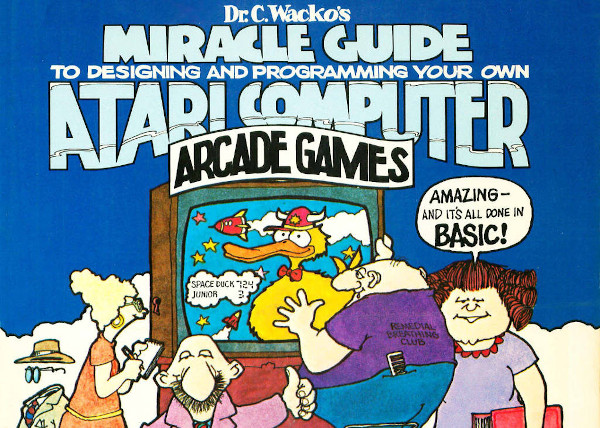
R-Cade Games: Simulating the Legendary Pong Game in R

Peter Prevos |
801 words | 4 minutes
Share this content
Pong is one of the earliest arcade games on the market, first released in 1972. From the day I first saw this miracle box, I wanted to know more about computers. There was something magical about being able to influence what happens on the television screen, even though the graphics left everything to t he imagintaion.
I learnt how to write code from the 1983 book Dr. C. Wacko's Miracle Guide to Designing and Programming your own Atari Computer Arcade Games. This book explains in a very clear and humorous way how to write computer games in Atari basic. I devoured this book and spent many hours developing silly games. This article is an ode to Dr Wacko, a computer geek's midlife-crisis and an attempt to replicate the software I developed thirty years ago.

I showed in a other posts that R can be used for board games or to play a text adventure. The question is whether we create arcade games in R. My challenge is to recreate the look and feel of 1980s arcade games, or R-Cade games, using R? The code shown below simulates the legendary game of pong.
Playing Pong in R
The code is based on the Wacko's Boing Program in the above-mentioned book. The R code is fully commented and speaks for itself. Please note that the animation is very clunky when you run it in RStudio. Only the native R Terminal displays the animation correctly.
This version plays automatically with a randomiser routine to render the gameplay imperfect. The skill parameter indicates how good the computer player is between 0 and 1.
The beepr library by Rasmus Bååth provides some much-needed sound.
The main issue with this code is that I have not been able to ad a human Pong player. I am not aware of a way to use continuous input in the R language. Perhaps somebody can help me perfect this little ditty. I love to know how to read real-time USB input to control the game, so we get a step closer to the first R-Cade game.
## Simulating the Legendary Pong Game in R
## Sound library
library(beepr)
## Game parameters
skill <- 0.87 # Skill (0-1)
score <- 0
high.score <- 0
## Define playing field
x11()
par(mar = rep(1,4), bg = "black")
plot.new()
plot.window(xlim = c(0,30), ylim = c(0,30))
lines(c(1, 30, 30, 1), c(0, 0, 30, 30), type = "l", lwd = 5, col = "white")
## Playing field boundaries (depends on cex)
xmin <- 0.5
xmax <- 29.4
ymin <- 0.5
ymax <- 29.4
## initial position
x <- sample(5:25, 1)
y <- sample(5:25, 1)
points(x, y, pch = 15, col = "white", cex = 2)
## Paddle control
psize <- 4
ypaddle <- y
## Set direction
dx <- runif(1, .5, 1)
dy <- runif(1, .5, 1)
## Game play
while (x > xmin - 1) {
sound <- 0 # Silence
Sys.sleep(.05) # Pause screen
points(x, y, pch = 15, col = "black", cex = 2) # Erase ball
# Move ball
x <- x + dx
y <- y + dy
# Collision detection
if (x > xmax) {
dx <- -dx * runif(1, .9, 1.1) # Bounce
if (x > xmin) x <- xmax # Boundary
sound <- 10 # Set sound
}
if (y < ymin | y > ymax) {
if (y < ymin) y <- ymin
if (y > ymax) y <- ymax
dy <- -dy * runif(1, .9, 1.1)
sound <- 10
}
# Caught by paddle?
if (x < xmin & (y > ypaddle - (psize / 2)) & y < ypaddle + (psize / 2)) {
if (x < xmin) x <- xmin
dx <- -dx * runif(1, .9, 1.1)
sound <- 2
score <- score + 1
}
# Draw ball
points(x, y, pch = 15, col = "white", cex = 2)
if (sound !=0) beep(sound)
# Move paddle
if (runif(1, 0, 1) < skill) ypaddle <- ypaddle + dy # Imperfect follow
# Draw paddle
# Erase back line
lines(c(0, 0), c(0, 30), type = "l", lwd = 8, col = "black")
# Keep paddle in window
if (ypaddle < (psize / 2)) ypaddle <- (psize / 2)
if (ypaddle > 30 - (psize / 2)) ypaddle <- 30 - (psize / 2)
# Draw paddle
lines(c(0, 0), c(ypaddle - (psize / 2), ypaddle + (psize / 2)), type = "l", lwd = 8, col = "white")
}
beep(8)
text(15,15, "GAME OVER", cex=5, col = "white")
s <- ifelse(score == 1, "", "s")
text(15,5, paste0(score, " Point", s), cex=3, col = "white")Share this content


